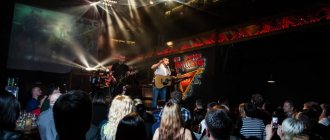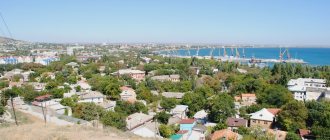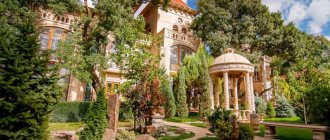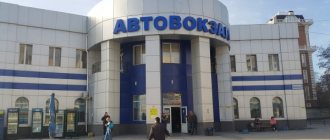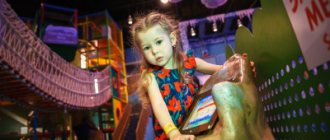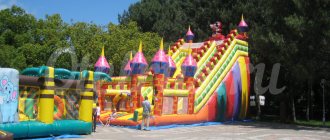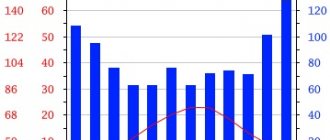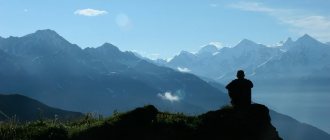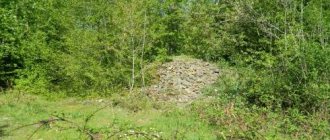What to see in Chekhov in 1 day – TOP-3
Of course, a tour of Chekhov can take 2-3 days, taking into account the interesting places in the surrounding area, but if you wish, you can see the main attractions of the city in one day. In this section we will consider three of the very best, reflecting the flavor of Chekhov.
Lopasnya-Zachatievskoe Estate Museum
- Address: Pushkina, 10.
A monument of architecture and landscape art. Built at the turn of the 18th-19th centuries. Within the estate there is a manor house in the Baroque style and a magnificent park on the river bank. A very beautiful place, which was visited with pleasure by the most famous people of Russia. The owners of the estate - the Vasilchikov family - gladly hosted the Pushkins, Goncharovs and Lanskys.
The museum is very young, but has managed to gain popularity among tourists and travelers. The estate has been restored, the landscape park has been put in order. Cascade ponds deserve special attention. They are incredibly beautiful in the warm season. Almost everyone who managed to visit the Lopasnya-Zachatievskoye museum complex claims that this is the most beautiful place in the Moscow region.
St. Nicholas Church at the churchyard in Rovki
- Address: Sanatornaya, 19.
Known since ancient times. At the beginning of the 17th century it was ruined. It was rebuilt several times in wooden form. It burned every time. Only at the beginning of the 20th century did the idea come to build a stone version of it. The project was great. They erected a one-domed church with a tent and a dome, and added a refectory and a bell tower to it. A priest's house was built nearby and a parochial school was organized.
However, the revolution of 1917 broke out. In the 1930s, the temple was closed. Then they rebuilt it beyond recognition. For example, instead of a bell tower, a water tower was installed. In this form, in 1995, the sacred landmark was handed over to believers. A mysterious place, not easy. Parishioners visit it with awe and reverence.
Park of Culture and Recreation
- Address: Moskovskaya st., 14.
He is very old. Broken in the 18th century. It is located on the bend of the Lopasnya River. Terraces and cascading ponds give it a special elegance. Each body of water has its own name: Rusalochy, Shchuchy, Bolshoy, Bakhmarinsky, Karasevy, Rechnoy, Rodnikovy. Some of them communicate with each other. At the bottom of each, oak wooden flooring was once installed. They were last seen in 2007 when the water was released.
The park is surrounded by rumors and legends. There is a holy spring, a magic stump, a mysterious gazebo. The townspeople dream of improving the park and are advocating for the installation of attractions in it. But the truth is that it is good in itself and can be declared a cultural site of regional importance.
Looking for inspiration: Sakhalin
Anton Chekhov. Photo: anton-chehov.info
Anton Chekhov. Photo: anton-chehov.info
Anton Chekhov. Photo: anton-chehov.info
Since 1887, Chekhov began to try himself in more serious genres and themes. The turning point in the writer’s work was the story “Steppe” for the magazine “Northern Messenger”. Chekhov found inspiration for it on a trip to the Azov region, during which he visited his homeland - Taganrog. "Steppe" was well received by the public. Chekhov’s friend, Moscow writer Vladimir Gilyarovsky, wrote: “Lovely! After all, this is a real, real steppe! You just breathe the steppe when you read.” In the same year, Chekhov’s first dramatic work, the play “Ivanov,” was staged at the Moscow Korsh Theater, and a year later his third collection, “At Twilight,” was awarded the Pushkin Prize at the Academy of Sciences.
... Mr. Chekhov's stories, although they do not fully satisfy the requirements of higher artistic criticism, nevertheless represent an outstanding phenomenon in our modern fiction literature.
From the resolution of the academic commission, 1888
In 1890, Anton Chekhov went to Sakhalin Island to explore the life of Russian prisons. The local administration forbade communication with political prisoners, but the writer violated this rule. He managed to conduct a census of the island's population, filling out ten thousand cards for its inhabitants. Five years later, an artistic and journalistic book of travel notes about the exile colony and hard labor, “Sakhalin Island,” was published.
Architectural sights of the city of Chekhov
There are real architectural gems in the city and its surroundings. Any tourist will be interested in looking at them after reading the descriptions and looking at the photographs.
Sadki Estate
- Address: st. Solnyshevskaya.
Founded by Serpukhov governor Andrei Eropkin. Known since the 17th century. Then it changed many owners. Then it was acquired by Mikhail Andreevich Ryumin. His son, Pyotr Mikhailovich, became the leader of the local nobility and was friends with A.P. Chekhov. He assisted the writer in all charitable projects.
The estate is famous for its ancient and very beautiful temple - the Church of John the Baptist. In 1812, a stone manor house was erected there. However, it was lost in the 1990s. All that remained was the church, the bell tower and an abandoned park. The main house was recreated in brick at the beginning of the 21st century, but it does not look like a new building. Its simplicity and elegance captivate at first sight.
Water tower
- Address: Gagarin street.
Built in 1961. Topped with a wooden tent covered in a protective net. It is constantly being destroyed, which leaves the local population in awe. The object is interesting, built with soul. This is evidenced by the date of construction, neatly laid out in white blocks on a red brick background. However, it was decided to demolish the tower soon. The townspeople hope that parking for cars will be installed in this place.
Outbuilding Chaika
- Address: Melikhovo estate.
Located in the Melikhovo estate. Built by A.P. Chekhov in 1894. According to legend, “The Seagull” was written there.
The small house is decorated with intricate carvings and a picturesque balcony. It has a high threshold and a plank gable roof. The steps from the porch immediately lead to the second floor right under the roof.
Initially, the outbuilding was intended for guests. The hospitable writer never knew where to accommodate his many friends, so he built an additional room. However, over time, he moved into a cozy house and spent all his time there.
Train Station
- Address: Vokzalnaya Square, 7D.
It is located in a historical building built in 1865. On one of its walls on the platform side there is a bas-relief of A.P. Chekhov with a memorial inscription. Despite its advanced age, the station looks impressive. In 2003, it was completely renovated. Now spontaneous trade reigns around it and people are bustling about. Everything is like at any other railway station.
Chekhov temples and churches
There are many churches and temples in the vicinity of Chekhov. Among them there are ancient buildings and outright remodels. But each has its own interesting story.
Conception Church
- Address: st. Pushkina, 7.
A snow-white five-domed structure. It was built back in 1694. According to legend, Anna, the wife of the steward S.L. Vasilchikova, could not give birth to a child. Then Savva Lukyanovich vowed to build a church in the village of Zachatevo. The woman became pregnant at the very beginning of construction. Since then the couple had many children. And they thank God for their family happiness.
The temple has a difficult fate. He owes his well-being to the Vasilchikov family. They added a refectory to it in 1821, and a bell tower in 1828. But after the October Revolution, the church was destroyed, and fifty years later it was completely closed. In 1988, it was returned to the Russian Orthodox Church in deplorable condition. However, through the efforts of the parishioners, it regained its former splendor.
There are three shrines in the temple: the miraculous Kazan Icon of the Mother of God, the face of St. Nicholas and the revered image of St. Seraphim of Sarov. All of them attract the attention of parishioners and, as reviews say, work wonders.
Church of St. Luke of Simferopol
- Address: st. Gagarina, 37.
It appeared on the initiative of believers in 2012. The fact is that church services in the Venyukovo district of the city of Chekhov were held in the foyer of a local hospital. When there was no longer enough space for everyone, the head physician thought about building a temple.
A few years later the project was realized. Now opposite the hospital there is a small wooden building with a golden dome and an Orthodox cross. It is painted in pink and purple tones. It looks very cozy and bright.
The temple was consecrated in honor of Luke of Simferopol, because he was not only a clergyman, but also a doctor. Parishioners turn to him asking for health for themselves and their loved ones.
Temple of John the Baptist
- Address: Rodnikovaya st., 6.
Located in the Sadki estate. It is incredibly beautiful. It was built back in the 17th century in honor of Peter Eropkin. The closest ally of Peter the Great was born and raised in these parts. He did a lot to transform the Motherland, but was treacherously killed after the death of the king.
For two centuries the church was preserved and ennobled. However, she had a hard time in the 20th century. It was destroyed several times, then a bakery was opened in it. And only on the threshold of the 1990s the temple was given into the hands of believers. By that time he was already on the verge of extinction.
Now it has been restored in all its splendor and beauty. It regularly receives Orthodox parishioners. There is a parochial school there.
Church of All Saints in Ivanovo
- Address: s. Ivanovskoe.
Erected at the turn of the 19th-20th centuries by manufacturer L.I. Medvedev. It amazed me with its grandeur. It was simply huge: brick, five-domed, with a large porch, a bell tower and numerous chapels. It was illuminated in honor of St. John the Merciful.
It was famous for its luxurious decoration. All the walls were covered with paintings, the crosses on the domes were painted in gold. In a word, she represented all the power of wealthy entrepreneurship. But she didn't last long.
The revolution of 1917 broke out. Of course, all the wealth of the church was nationalized. In 1939, a library and medical center opened in the building. In 1970, the temple was abandoned. It was only in 2001 that services were resumed there.
The church is now being actively restored. It has been given the status of a cultural heritage site of regional significance.
Assumption Church in Novoselki
- Address: s. Novoselki.
Built on the site of an ancient wooden church, consecrated in honor of St. George the Victorious in 1750. Equipped with a refectory and a bell tower. Made in Baroque style. During Soviet rule it was not closed.
The bright and tall Chekhov Church stands on the edge of the forest. Nearby is a cemetery where entire families are buried. People come here to pray and then visit their deceased relatives.
Church of the Transfiguration of the Lord in Chudinovo
- Address: Chudinovo village.
In the village of Chudinovo there is another Orthodox shrine, which is an interesting attraction. The Transfiguration Church has been pleasing parishioners not so long ago, but has already managed to earn positive reviews. Believers note that this is a quiet and holy place where you can pray, light a candle, and listen to solemn services.
Holy Spring of St. David
- Coordinates on the map – 55.087979, 37.699709.
It is located in the vicinity of the village of Talezh in the closed territory of the monastery. Considered a sacred place. The water from this source has healing properties. Not far from the spring there is a stone on which a prayer is carved. A religious complex rises above the spring - the Compound of the Ascension David Hermitage.
Where to go in Chekhov with a child
The city of Chekhov is located on the banks of the Lopasnya River. It is literally surrounded by greenery. Its parks and squares are amazing, especially attracting families with children of all ages.
Boulevard A.P. Chekhov
- Address: Chekhov Boulevard.
Beautiful and cozy place. On Chekhovsky Boulevard there is a fountain, benches, and street lighting. Trees are planted around and flower beds are laid out. There is a bench with an umbrella and romantic inscriptions. The townspeople love this boulevard very much. They often come here with the whole family.
Adventure Park "Wild Squirrels"
- Coordinates: 55.156893, 37.631931.
This is a whole argot-educational complex. Opened in 2015. Designed for children. It consists of three large entertainment areas: an adventure park, an adventure labyrinth and a clearing for team games.
The creators of the entertainment complex have grandiose plans. They own a farm with alpine goats. Products from this enterprise are offered to visitors in the Gorynych grill bar. Many have managed to appreciate the taste of dairy in this establishment. Extraordinarily delicious milk, cottage cheese, feta cheese, cheese, etc. are served here.
In addition, the adventure park plans to organize an indoor park and an unusual campsite. All for outdoor fun!
Birch Grove
- Address: st. Oktyabrskaya.
A good place for walking with children and animals. Equipped with benches, paths, benches and a playground. There is a place for sports exercises. There are usually few people. That's why those who love solitude come here.
Ice Palace "Vityaz"
- Address: Moskovskaya st., 104.
However, with a child in Chekhov it will be interesting not only to wander through the parks. So, many children after 6-7 years of age are happy to try their hand at skating. In the city there is an excellent skating rink for them on the territory of the Vityaz Sports Complex.
There are affordable prices for holidays, excellent conditions of stay, there is a buffet with a large selection of snacks and full meals. There is also a sports equipment store here, where children or adults can be helped to choose the best equipment for ice recreation.
Escape to Moscow
Anton Chekhov. Photo: anton-chehov.info
Anton Chekhov. Photo: anton-chehov.info
Anton Chekhov. Photo: anton-chehov.info
In 1876, Chekhov Sr. went bankrupt, and the whole family left for Moscow. Sixteen-year-old Anton, who was completing his studies at the gymnasium, was left alone and tutored to earn his living. During these years, he read a lot, wrote essays for gymnasium magazines, and sent the magazine “Zaika” with short sketches from Taganrog life to his brothers in Moscow. At the same time, Chekhov wrote his first play, “Fatherlessness,” and the vaudeville “No wonder the hen sang.”
In 1879, Chekhov graduated from high school and left Taganrog for Moscow. There he began to take care of his family, providing for his loved ones with a modest income from literary publications. Chekhov’s debut in print took place in December of the same year: the magazine “Dragonfly” published the story “Letter to a Learned Neighbor” and the humoresque “What is most often found in novels, stories, etc.”
In the same year, Chekhov entered the medical faculty of Moscow University named after I.M. Sechenov. The medical student lived with his brother Ivan in Voskresensk near Moscow (today the city of Istra). There, in 1881, he met the head of the Resurrection Zemstvo Hospital, Dr. Pavel Arkhangelsky. Even during his studies, Chekhov received patients, completed his internship here, and after graduating from the university he remained to work as a district doctor. In the summer of 1884, he moved to the position of head of the Zvenigorod hospital.
Museums and theaters of Chekhov
Many museum exhibitions in Chekhov are associated with the name of A.P. Chekhov. But the city also has a wonderful local history complex with many interesting exhibits. There is also a theater here.
Museum of Letters of A.P. Chekhov
- Address: st. Chekhova, 4A.
It is located in the building of the former Lopasnensky post and telegraph office, which opened here in 1896 and existed for 10 years. It is associated with the name A.P. Chekhov - it was on his initiative and the request of local residents that the postal service was published. Nowadays, in the postal building there is a museum exhibition “The History of Postal Business in Lopasnya”. It opens unique pages of Russian life and culture.
Chekhov Museum-Reserve "Melikhovo"
- Address: Melikhovo village.
The exhibition here is dedicated to the life and work of Anton Pavlovich. Here he lived for seven years and wrote his best works. The estate was made a memorial in 1940. By that time, only the outbuilding “Chaika” remained from it. During the war, museum life was suspended, but then resumed with renewed vigor. Now on a tour of Melikhovo, tourists will be able to see many of the writer’s personal belongings. On the territory of the estate there are: a manor house, a bathhouse, a kitchen, a “Chaika” outbuilding, a fire shed, an ancient medical center, etc.
Museum of Memory of the Lopasnensky Region
- Address: st. Chekhova, 28.
The main mission of this institution is to participate in the life and cultural development of their native land. The museum strives to be interesting for all categories of people. Mature and young, native residents and visitors, schoolchildren and working citizens come here with equal interest. The most famous exhibitions are dedicated to the Great Patriotic War, the life and work of Chekhov, the events of the October Socialist Revolution, and the folk crafts of the city district.
Memorial Melikhovo School
- Address: Melikhovo.
It was built through the efforts of Chekhov. During his stay in Lopasna, he built three schools. All of them resemble not cramped village shacks, but spacious manor houses. The rooms have high ceilings and large windows. The facades are decorated modestly but tastefully.
The buildings were built so well that they have been remarkably preserved to this day. The Melikhovo school was used for its intended purpose until the 1970s, and then was transferred to the local museum. Everything in it is as it was at the end of the 19th century.
MBUK Chekhov City Theater
- Address: Moskovskaya st., 40.
This theater has a long and glorious history. It was created back in 1917, was called the people's theater and was located in a stone merchant's house. Moscow Art Theater artists performed on its stage. There they “tested” their premieres.
In 1941, part of the building was demolished by a Nazi aerial bomb. By the end of the 1940s. it was restored and performances began to be shown there again. Over the many years of its existence, the theater center has acquired a regular audience. Festivals, competitions, concerts and various performances are held here, and plays are staged.
The doctor became a writer
Nikolai Chekhov. Portrait of Anton Chekhov (fragment). 1884. State Literary Museum, Moscow
Valentin Serov. Portrait of Anton Chekhov (fragment). 1902. State Literary Museum, Moscow
Isaac Levitan. Portrait of Anton Chekhov (fragment). 1886. State Tretyakov Gallery, Moscow
Anton Chekhov combined his studies at the university with constant literary work. He published mainly under the pseudonym Antosha Chekhonte; later “A Doctor Without Patients”, “Uncle”, “A Man Without a Spleen”, “Baldastov”, “Antonson”, “My Brother’s Brother” appeared - about fifty in total.
Chekhov was published in the Moscow humorous magazines “Alarm Clock”, “Spectator”, “Oskolki”, collaborated with the “Petersburgskaya Gazeta”, the newspaper “Novoe Vremya” and “Russkie Vedomosti”. In 1882, the writer completed work on his first collection of short stories, “Prank,” but it was never published, probably due to financial problems. Chekhov's first collection, Tales of Melpomene, was published in 1884.
By 1885, Chekhov was already a popular author of short stories. But the writer Dmitry Grigorovich intervened in his literary path, who criticized the young man for wasting his talent. Many leading authors and critics of those years agreed with this opinion.
Better starve, as we starved in our time, save your impressions for work that is thought out, processed, written not in one sitting, but written in the happy hours of your inner mood. One such work will be valued a hundred times more than hundreds of wonderful stories scattered across newspapers at different times.
From a letter from Dmitry Grigorovich to Anton Chekhov, 1886
But it was thanks to one of the critics, publisher Alexei Suvorin, that Chekhov was able to reveal his potential. In Suvorin’s magazine “New Time,” with which Chekhov began collaborating, the authors were paid a decent fee and were not limited either in the time of creation of works or in the number of words. It was during this favorable time for the writer that some of his best works were published: “Dirge”, “Enemies”, “Agafya”, “Nightmare” and others - and Chekhov’s story appeared as a new phenomenon in Russian literature. In "New Time" Anton Chekhov first began to sign texts with his own name.
However, with the five stories published in New Time, I caused a stir in St. Petersburg, from which I was as mad as a child.
From a letter from Anton Chekhov to his brother Alexander, 1886
Beautiful monuments and memorials in Chekhov
In fact, they can be divided into two groups - Monuments dedicated to the Second World War and Monuments to great people. They are all unusual and deserve to be photographed next to them.
Memorial of the Great Patriotic War
- Address: Boulevard of Military Glory.
Installed in memory of those who, not sparing their lives, defended their Motherland. Located in the Central Square. It is in excellent condition. The monument is a marble stele with a hanging bell, which stands on a stepped granite pedestal. The names of Heroes of the Soviet Union who were born in Chekhov are engraved on the bell. A beautiful and significant place that is regularly visited by citizens and visitors.
Monument to Tank T-34
- Address: Pervomaiskaya, 19.
Truly this is a legendary monument in Chekhov, especially popular among the people. The T-34 tank installed here is real, it was delivered from Kursk. At one time it was used as a reserve tractor, and then was placed on a pedestal in honor of the tank heroes who fought in the Chekhov area in 1941. The monument was inaugurated in 1980 - in honor of the 35th anniversary of the Great Victory.
Monument to Prokin
- Address: A.M. Boulevard Prokina.
Prokin Alexey Mikhailovich is a teacher, local historian and honorary resident of the city of Chekhov. He took part in the fighting of the Second World War, was demobilized and worked all his life at a local school. He invested a lot of effort into the creation of the school Museum of Local Lore and the Museum “In Memory of 1941-1945”. A monument in his honor was erected by grateful students. The square in which it is located also bears the name of Prokin.
Lenin monument
- Address: Boulevard named after V.I. Lenin.
Located in a small park. It looks quite impressive. On a high black pedestal stands a bronze monument to the leader. He's wearing a three-piece suit. He keeps his hands in his trouser pockets and looks intently down at those who came to take photos with the memorial place. There is a flower bed around the pedestal. At the feet of V.I. Ulyanov there is a wreath. A very clean, well-kept place that evokes only pleasant associations.
Monument to Chekhov
- Address: Chekhov Boulevard.
This memorial object has a fairly long history. In 1960, a competition was announced in Moscow for the best monument to the writer. The sculptor M.A. also took part in it. Anushkin. He lose. However, he did not abandon the project. For 30 years he improved his work, until a new request came to the capital - from a museum in the city of Chekhov. The sculptor decided to give the statue to the great man’s fellow countrymen.
As you can see in the photo, this is an unusual sculpture. It depicts a mature writer standing on a small pedestal wearing a long coat. He has a haggard face and a tired look. A cane in one hand, a hat in the other. He looks both similar and different from himself. The author of the monument said that he wanted to show people a different writer. Contemporaries claimed that his face changed greatly with age. And along with him, his inner world changed.
Worship cross
- Address: Officer Village street.
It was installed and consecrated in August 2015. Opened in honor of the 70th anniversary of Victory in the Second World War. Dedicated to officers who distinguished themselves in the battles of the Great Patriotic War. They received plots of land in the area of Lopasnya (present-day Chekhov) and founded the village of Ofitsersky there. Now people come to bow to their blessed memory.
Index Talezh
- Coordinates: 55.083030, 37.687645.
Interesting attraction. The sign looks more like a fairytale amulet than a standard road sign. At the fork in two roads there is a building in the form of a house with three spacious entrances. At the top there is a golden dome with an Orthodox cross. In the center there is an arrow on which hangs a scroll with the inscription: “Talezh. Holy Spring of St. David." An unusual meeting immediately puts travelers in a romantic mood. Everyone wants to get to the place the arrow points to.
Variety of entertainment in Chekhov
Having fun in Chekhov will also not be difficult. Several educational and entertainment establishments have been prepared for citizens and tourists where they can go in the evening or even at night.
Cultural and creative
- Address: st. Chekhova, 45.
Residents of Chekhov in some reviews claim that the Druzhba cultural and entertainment center is perhaps the most popular and sought-after place for cultural leisure in the city, both for adults, the elderly, and for children and teenagers.
Inside, “Friendship”, as well as outside, is very beautiful. Visitors immediately tune in to a positive mood when observing such beauty. Guests can enjoy a concert venue, various clubs/sections, and even an excellent gym.
Estate "Peshkovo"
- Address: Peshkovo village.
Located in a village of the same name, 6 km west of Chekhov itself. It is a complex for country holidays. Three two-story log houses and a hotel with 14 rooms are available to visitors here. The pride of the establishment is its two-story wood-fired bathhouses, built according to all the principles of Russian architecture.
The estate has a platform for holding special events and a conference room with special equipment for business meetings (flipchart, screen, projector). After work, guests can swim in the pool or play billiards. Reasonable prices, good service, great outdoor recreation - you will find all this in Peshkovo.
Sports Palace "Olympic"
- Address: st. Printers, 30.
A place where you can enjoy active recreation. There is a swimming pool, massage room, solarium, and gyms. But the most important thing is a wonderful sports arena. Many significant events were held in this sports palace: matches for the European Handball Cup, an international boxing tournament, etc. Visitors will see many other important events from the world of sports in the future.
Restaurant "Dzhambu"
- Address: Starye Kuzmenki village, territory of the Yuzhny nursery.
An establishment with an amazing level of service, for a small town in the Moscow region. Here you are treated to delicious dishes in a cozy, memorable interior. Everything around seems bright, light and airy. Huge panoramic windows overlook the garden. The rooms are decorated in a luxurious oriental style. Some Chekhovites complain about high prices. But many in their reviews assure that the treats in the restaurant are worth the money they ask for, arguing that Jambu is not inferior to the most pretentious establishments of this type in Moscow .
House of Culture "Rus"
- Address: Manushkino village, 28.
In the south of Chekhov, next to the Manushkin school, there is a recreation center "Rus". The place is very beautiful and interesting in all respects. Here, visitors can enjoy the best concerts in the city, exciting show programs, and exciting performances. As in “Druzhba”, there are several sports sections, the prices for which are more than reasonable. But the staff of the establishment, unfortunately, is not always friendly.
Here are reviews of other cities in the Moscow region, be sure to check them out:
- Klin, Balashikha, Lyubertsy, Zelenograd, Elektrostal,
- Podolsk, Krasnogorsk, Voskresensk, Ramenskoye, Reutov,
- Khimki, Dmitrov, Odintsovo, Dolgoprudny,
- Yegoryevsk, Pushkino, Taldom,
- Shchelkovo, Naro-Fominsk, Noginsk, Bronnitsy, Lobnya,
- Kolomna, Volokolamsk, Korolev, Vereya, Stupino,
- Zaraysk, Serpukhov, Domodedovo, Sergiev Posad.
Anyone interested in Russian history and culture must visit Chekhov, because this wonderful atmospheric city will certainly delight you with its beauty and originality, expressed in numerous and interesting sights.
Visit to the Orlovsky equestrian complex
Upon arrival in Chekhov, where to go with older children, the choice may fall on one of the equestrian clubs, for example, the Orlovsky equestrian complex. They offer a variety of horse riding training services, as well as many offers for those who know how to ride a horse.
Simple communication with horses, which has a positive effect on the mental development of the younger generation, will not be superfluous. Horseback riding with the whole family will bring maximum pleasure to riders of all ages.
Back to Contents
